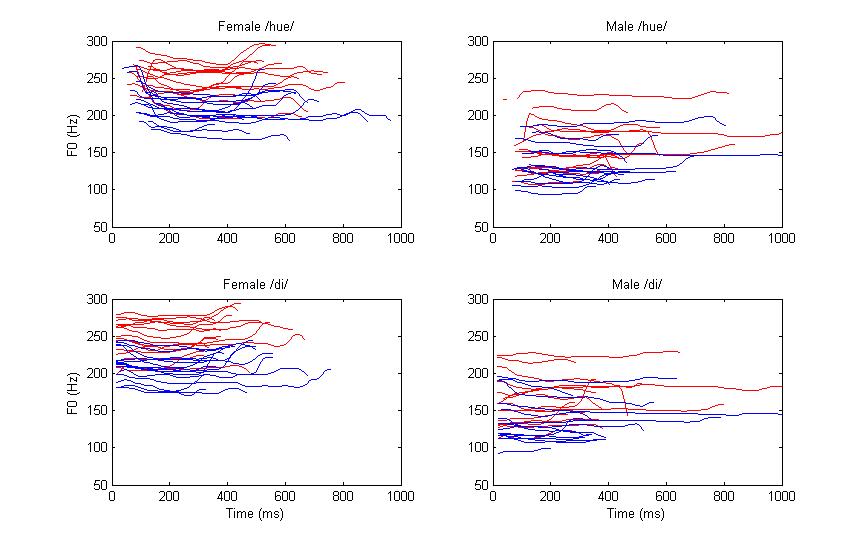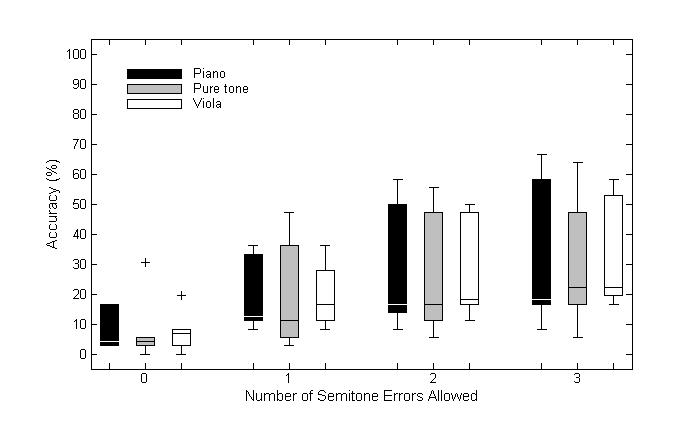
Figure 1: F0 contours of the /hue/ and /di/ stimuli used in the Taiwanese tone identification experiment. Red lines indicate high tone stimuli and blue lines indicate mid tone stimuli.
Chao-Yang Lee – leec1@ohio.edu
Allison Lekich – allison.lekich@gmail.com
Division of Communication Sciences and Disorders
Ohio University
Athens, Ohio 04701
Popular Version of Paper 1aMU6
Presented Monday morning, October 22, 2012
164th ASA Meeting, Kansas City, Missouri
Pitch is a major auditory attribute of music. It is also used to distinguish words in many tone languages. Since pitch plays a prominent role in both music and language, an intriguing question is whether the ability to process musical pitch is associated with the ability to process linguistic pitch. Previous research showed that musical training facilitates non-tone language users' ability to produce and perceive lexical tones (e.g., Alexander et al., 2005). Deutsch and colleagues further proposed that lexical tones are associated with absolute pitch, the ability to produce or name a musical tone without a reference pitch (e.g., Deutsch et al., 2006). In this study, we explored the music-language relationship by investigating the perception of musical and lexical tones by musicians and non-musicians without knowledge of lexical tones.We asked the following questions:
1. Can listeners judge the pitch height of lexical tones reliably even without knowledge of the target language?
2. Will musicians identify lexical tones with higher accuracy than non-musicians?
3. Is the ability to identify lexical tones associated with the ability to identify musical tones without a reference pitch?
Six musicians and 36 non-musicians participated in a Taiwanese tone identification task. All participants were native speakers of English and had no knowledge of tone languages. They listened to pairs of Taiwanese words that contrast only in tone (e.g., /hue/ with a high-level tone, meaning "flower"; and /hue/ with a mid-level tone, meaning "meeting") produced by 30 female and male speakers. Figure 1 shows the F0 contours of the stimuli, which show substantial overlap between the high and mid tones across speakers. The task for the listeners was to judge whether a stimulus tone was a high or mid tone. Given the variability across speakers, the task required listeners to judge pitch height relative to the estimated pitch range of the speakers.

|
Figure 1: F0 contours of the /hue/ and /di/ stimuli used in the Taiwanese tone identification experiment. Red lines indicate high tone stimuli and blue lines indicate mid tone stimuli. |
Figure 2 shows the accuracy of identifying pitch height of the tones. Statistical analyses showed that only high tones produced by female speakers and mid tones produced by male speakers were identified above chance (50%). In other words, listeners were able to identify tones reliably only in the extremes of the speakers' pitch range, where there is relatively less overlap between the high and mid tones across speakers. There was no effect of musical training: The non-musicians performed as accurately as the musicians.
 |
The six musicians also participated in a musical tone identification task. They listened to 108 synthesized musical tones of three timbres (pure tone, piano, and viola) ranging from A3 to B5. Their task was to identify the notes. Performance on this task was graded based on how close the responses matched the stimulus tones, shown in Figure 3. Accuracy was generally low and none of the musicians met the criterion for absolute pitch, defined as 85% accuracy with 0 or 1 semitone errors for the piano stimuli.
 |
Figure 3: Box plots showing the accuracy of musical note identification as a function of timbre and number of semitone errors allowed. The central mark is the median, the edges of the box are the 25th and 75th percentiles, the whiskers extend to the most extreme data points not considered to be outliers, and outliers are indicated by "+."
To evaluate the association between lexical and musical pitch perception, we calculated Pearson's correlation coefficients between measures of Taiwanese tone identification accuracy and musical tone identification accuracy. The values of the coefficients were generally low and none of them were statistically significant. In other words, our data did not provide evidence for the association between lexical and musical pitch perception.
In summary, the data we have collected so far showed that listeners without knowledge of lexical tones can identify pitch height above chance, but only for tones in the extremes of the speakers' pitch range. This contrasts with our previous study with Taiwanese-speaking musicians, who were able to identify all tones above chance irrespective of where the tones are in the speakers' pitch range (Lee et al., 2011). Second, we did not find evidence that musicians had an advantage in the lexical tone identification task. This contrasts with our previous study using Mandarin tones (Lee and Hung, 2008). Since Mandarin tones differ from each other primarily in pitch contour rather than pitch height, the musicians' superior performance in that study is likely due to their ability to track pitch movements more effectively. Third, we did not find evidence for the association between lexical and musical pitch height perception. This is consistent with our previous studies using Mandarin and Taiwanese tones (Lee and Hung, 2008; Lee & Lee, 2010; Lee et al., 2011). Since the number of musicians tested in the current study is relatively small and none of them actually possess absolute pitch, these findings should be verified with a larger sample of musicians in future studies.
References:
Alexander, J., Wong, P. C. M., and Bradlow, A. (2005). "Lexical tone perception in musicians and nonmusicians," Proceedings of Interspeech' 2005-Eurospeech-9th European Conference on Speech Communication and Technology. Lisbon, Portugal.
Deutsch, D., Henthorn, T., Marvin, E., and Xu, H. (2006). "Absolute pitch among American and Chinese conservatory students: Prevalence differences, and evidence for a speech-related critical period," J. Acoust. Soc. Am. 119, 719-722.
Lee, C.-Y., and Hung, T.-H. (2008). "Identification of Mandarin tones by English-speaking musicians and non-musicians," J. Acoust. Soc. Am. 124, 3235-3248.
Lee, C.-Y., and Lee, Y.-F. (2010). "Perception of musical pitch and lexical tones by Mandarin-speaking musicians," J. Acoust. Soc. Am. 127, 481-490.
Lee, C.-Y., Lee, Y.-F., and Shr, C.-L. (2011). "Perception of musical and lexical tones by Taiwanese-speaking musicians," J. Acoust. Soc. Am. 130, 526-535.